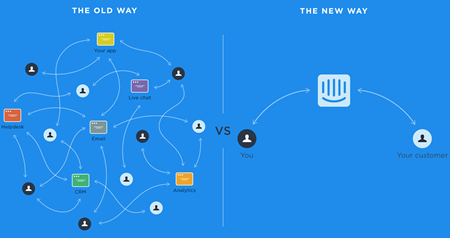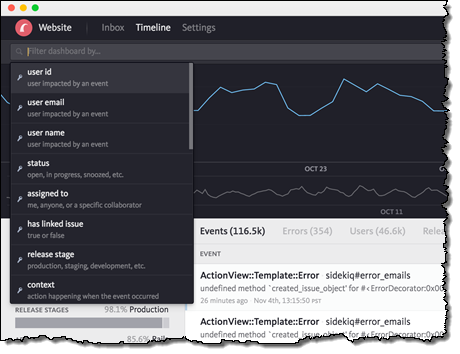AWS News Blog
Hot Startups on AWS – March 2016
|
|
We love startups!
When energy, enthusiasm, creativity, and passion for changing the world come together to build new and exciting businesses and applications, everyone benefits. Today I am kicking off a new series of posts. Every month I am going to feature a handful of hot, AWS-powered startups and tell you a little bit about what they built. I hope to explore a bit of the motivation behind the products and the startups and to show you how AWS has empowered them to put that energy, enthusiasm, creativity, and passion to use.
Today’s post features the following startups:
- Intercom – One place for every team in an Internet business to see and talk
- to customers, personally, at scale.
- Tile – A popular key locator product that works with an app to help people find their stuff.
- Bugsnag – A tool to capture and analyze runtime errors in production web & mobile applications.
- DroneDeploy – Making the sky productive and accessible for everyone.
Intercom
 The founders of Intercom previously ran a SaaS business in Dublin, Ireland. They had a problem- they didn’t know who their customers were, and couldn’t easily communicate with them. They were working on a solution when they observed a coffee shop owner casually interacting with his customers, greeting them by name, making offers tailored to their interests, addressing questions, and heading off potential problems. The founders decided to build a tool that would allow others building online businesses to have a personal touch with their customers, as opposed to simply treating them like rows in a database.
The founders of Intercom previously ran a SaaS business in Dublin, Ireland. They had a problem- they didn’t know who their customers were, and couldn’t easily communicate with them. They were working on a solution when they observed a coffee shop owner casually interacting with his customers, greeting them by name, making offers tailored to their interests, addressing questions, and heading off potential problems. The founders decided to build a tool that would allow others building online businesses to have a personal touch with their customers, as opposed to simply treating them like rows in a database.
The resulting platform, Intercom, is a fundamentally new way to communicate with customers. It allows web and mobile businesses to track live customer data, and use that data to communicate with customers in a personal way on their website, inside web and mobile apps, and by email. A little bit of JavaScript (for web apps) or simple SDKs for (iOS and Android) powers live chat, marketing automation, customer feedback, and customer support.
Intercom chose AWS to allow them to move fast without having to have a large operations team. With thousands of businesses already using the product, they needed to keep the real-time conversations running at a consistent speed and with low latency. When they anticipated running up against the limits of their existing relational database and began to consider a sharded solution, they put Amazon Aurora to the test and found that it was able to handle their current load, with plenty of room to grow. They avoided the complexity of sharding, lowered their costs, and reduced the latency of their queries.
Tile
 One of the founders of Tile was frustrated because his spouse had a habit of losing things. After looking in to some ways to help her, he realized two things. First, this was a very common problem (and, to be fair, one that is not gender-specific). Second, no one was addressing it. Seeing an opportunity, he co-founded Tile in 2013 and created a crowdfunding campaign to secure capital. This campaign surpassed the initial goal of 10,000 units by 20x, which delivered a key indicator that the team had found a good solution to an unmet need. Currently, the company has sold over 4.5 million Tiles, making this one of the most successful crowdfunded companies to date.
One of the founders of Tile was frustrated because his spouse had a habit of losing things. After looking in to some ways to help her, he realized two things. First, this was a very common problem (and, to be fair, one that is not gender-specific). Second, no one was addressing it. Seeing an opportunity, he co-founded Tile in 2013 and created a crowdfunding campaign to secure capital. This campaign surpassed the initial goal of 10,000 units by 20x, which delivered a key indicator that the team had found a good solution to an unmet need. Currently, the company has sold over 4.5 million Tiles, making this one of the most successful crowdfunded companies to date.
The Tiles themselves are small and simple. They can be attached to all different sorts of objects, and use Bluetooth Low Energy to communicate. When the mobile app is activated, it displays a proximity radar with range of about 100 feet, and the app can also be used to trigger a loud (90 decibel) chime on the Tile. Conversely, the Tile itself can be used to find a missing smartphone. The app can even display the last known location of each Tile on a built-in map; this is useful if the Tile is out of Bluetooth range. Finally, if the misplaced item is well and truly lost, a community-based feature can be used to provide an anonymous ping if another user’s running app comes within Bluetooth range of the missing item. Based on these functionality options, Tile is ideal for finding anything that can be lost or misplaced, from lost keys, remote controls, cell phones, and other high-value objects, large or small.
Tile chose AWS to allow them to scale rapidly and to have a global presence (they have devices in 214 countries & territories). They run multiple applications (the Tile Web App, Customer Service, and the Tile Network) on AWS using EC2, Route 53, RDS, CloudWatch, SNS, Kinesis, and Redshift. They currently process over 100 million location updates every day and regularly add new servers, modify load balancers, and update DNS entries.
Bugsnag
 This hot startup was founded in a tiny San Francisco apartment that was home to Simon and James (the two founders), their respective partners, and a four-pack of cats. They wanted to provide developers of web and mobile applications with a tool that would intercept, track, and report on application crashes with an eye toward aggregated, prioritized reporting and analysis. Given the fragmented state of the mobile device world, being able to use Bugsnag to identify issues that are peculiar to one platform, device, or version ensures that developers are focused on fixing bugs that affect the most users.
This hot startup was founded in a tiny San Francisco apartment that was home to Simon and James (the two founders), their respective partners, and a four-pack of cats. They wanted to provide developers of web and mobile applications with a tool that would intercept, track, and report on application crashes with an eye toward aggregated, prioritized reporting and analysis. Given the fragmented state of the mobile device world, being able to use Bugsnag to identify issues that are peculiar to one platform, device, or version ensures that developers are focused on fixing bugs that affect the most users.
Bugsnag helps thousands of companies to improve the quality of their web and mobile applications. It integrates with many languages and environments including Rails, JavaScript, Python, Go, PHP, iOS, and Android. The product captures detailed crash data, packages it up for analysis (including an encryption step), and then uploads the information to AWS where it can be used to create tickets, issue notification to tools like HipChat and Slack, and so forth. Bugsnag also includes a dashboard that supports analysis of trends over time, data-driven root cause analysis, and multiple key/value filters.
The load on Bugsnag depends on the applications shipped by their customers and can vary greatly from day to day. They currently process up to a billion crashes per day. In order to handle this large, unpredictable load as economically as possible they make use of a multitude of AWS services including a mix of On-Demand and Spot instances. Their worker fleet is comprised of a mix of both kinds of instances, managed by a pair of Auto Scaling groups. The first group contains the Spot instances. It scales up aggressively and scales down slowly. The second group contains the On-Demand instances. It scales up conservatively and scales down aggressively. To learn more about how they did this, read their blog post, Responsive infrastructure with Auto Scaling.
DroneDeploy
 In 2013, three entrepreneurs in South Africa got together to plan a new venture. After observing that off-the-shelf drone hardware was maturing far more rapidly than the software needed to get the most value out of that hardware, they started DroneDeploy. Their vision was to make the sky productive and accessible to everyone. They wanted to remove complexity in order to allow companies to operate fleets of drones safely, reliably, and simply. They also wanted to give their customers the ability to process the data collected by the drones.
In 2013, three entrepreneurs in South Africa got together to plan a new venture. After observing that off-the-shelf drone hardware was maturing far more rapidly than the software needed to get the most value out of that hardware, they started DroneDeploy. Their vision was to make the sky productive and accessible to everyone. They wanted to remove complexity in order to allow companies to operate fleets of drones safely, reliably, and simply. They also wanted to give their customers the ability to process the data collected by the drones.
They launched the first version of their code in 2014. Since then they have attracted customers in industries as diverse as construction, agriculture, surveying, and mining (many interesting stories can be found on the DroneDeploy Blog). Here are a few examples:
- A customer in Mexico processed 1000 km of road imagery in just 3 weeks (114,043 images / 8 terabytes of data).
- A potato farmer in North Dakota mapped a 150 acre field, processed the data (30 minutes), and evaluated crop damage.
- A construction manager in Oklahoma used DroneDeploy to monitor the construction of oil tanks and pipelines, producing 3D models in the process.
DroneDeploy is processing images from 100 countries into interactive maps and 3D models. They host their core infrastructure on AWS. They make heavy use of EC2 for image processing and S3 for storage (multiple petabytes). The image processing fleet is auto scaled up and down based on the number and priority of jobs, spread out across multiple Availability Zones.
— Jeff;
